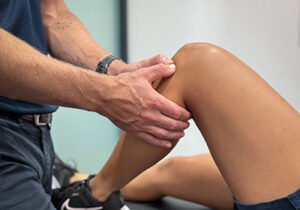
Knee Pain: Causes, Treatments, and Prevention Tips
Knee Pain: Causes, Treatments, and Prevention Tips
What is Knee Pain?
Knee pain is a common condition that affects people of all ages and activity levels. It can range from mild discomfort to severe pain that limits mobility and daily activities. The knee joint is a complex structure comprising:
- Bones – The femur (thigh bone), tibia (shin bone), and patella (kneecap).
- Cartilage – Acts as a cushion between bones to reduce friction.
- Ligaments – Provide stability to the joint.
- Tendons – Attach muscles to bones and facilitate movement.

Because of its complexity, the knee is vulnerable to injury and wear-and-tear over time. Knee pain can arise from acute injuries, chronic conditions, or underlying medical issues.
Keep reading for more information about the causes of knee pain, treatments and preventative tips from the knee physio experts at My Physio Duncraig.
What Causes Knee Pain?
There are numerous potential causes of knee pain, including:
1. Injuries
- Ligament tears (e.g., ACL or MCL injuries)
- Meniscus tears
- Fractures
- Patellar dislocations
2. Osteoarthritis
A degenerative joint disease that leads to cartilage breakdown, causing pain, stiffness, and reduced knee function.
3. Tendinopathy
Previously known as tendonitis, this condition involves inflammation of the tendons around the knee, often caused by repetitive movements like running or jumping.
4. Bursitis
Inflammation of the bursae (fluid-filled sacs that cushion the knee), leading to localized swelling and pain.
5. Patellofemoral Pain Syndrome (Runner’s Knee)
Knee pain when running, or from a change in running distance. This knee pain can also be caused by an overload (overuse) or muscle imbalances.
6. Inflammatory Conditions
- Gout
- Rheumatoid arthritis
These conditions affect the joints, causing knee pain, swelling, and stiffness.
7. Mechanical Issues
- Iliotibial (IT) band syndrome
- Kneecap instability
- Biomechanical abnormalities
What Treatments Can Assist with Knee Pain?
Best treatments for knee pain depend on the underlying cause and severity. Common approaches include:
1. Rest and Activity Modification
Reducing or modifying high-impact activities and allowing the knee to heal is essential for recovery.
2. Physiotherapy for Knee Pain Relief
Manual therapy, dry needling, stretching, strengthening exercises, and a structured return-to-activity plan can improve knee stability, mobility, and function.
3. Pain Relief Medications
Nonsteroidal anti-inflammatory drugs (NSAIDs), such as ibuprofen, can help manage pain and inflammation.
4. Ice and Heat Therapy
- Ice reduces swelling.
- Heat improves circulation and eases stiffness.
5. Bracing and Support
Knee braces, taping, or orthotics may provide additional stability and pain relief.
6. Injections
Corticosteroid or hyaluronic acid injections can help relieve pain for conditions such as arthritis.
7. Surgery
For severe cases, surgical options like meniscus repair, ligament reconstruction, or knee replacement may be necessary.
How Can I Prevent Knee Injuries?
Taking preventive measures can help reduce the risk of knee pain and injuries:
1. Strengthening Exercises
Focus on strengthening the quadriceps, hamstrings, and glutes to enhance joint stability.
2. Proper Warm-Up and Cool-Down
Engage in dynamic warm-ups before activity and stretch afterward to prevent injuries.
3. Maintain a Healthy Weight
Excess weight puts additional stress on the knee joints, increasing the risk of pain and degeneration.
4. Wear Supportive Footwear
Properly fitted shoes with good arch support reduce strain on the knees.
5. Avoid Overuse and Sudden Activity Increases
Gradually increase activity levels and incorporate rest days to prevent overuse injuries.
6. Listen to Your Body
Address early signs of knee discomfort and seek professional advice to prevent more severe issues from developing.
Get Expert Help for Knee Pain
Struggling with knee pain? Meet the My Physio team and get an accurate diagnosis and a personalised treatment plan for lasting relief! Book online or call 9447 6152 today for a consultation at our Duncraig Physio clinic.